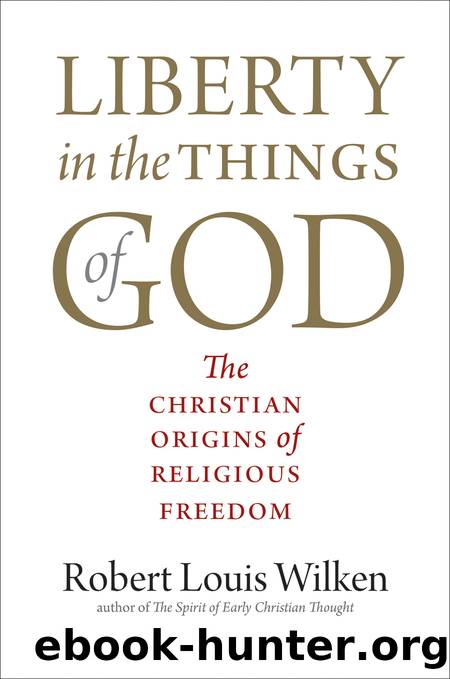Liberty in the Things of God by Robert Louis Wilken

Author:Robert Louis Wilken
Language: eng
Format: epub
ISBN: 9780300245493
Publisher: Yale University Press
CHAPTER SEVEN
Sturdy Piety
Catholics in England
Liberty of conscience is like unto liberty of breathing and using the common aire.
âROBERT PERSONS, SJ
LONG BEFORE THE REFORMATION of the sixteenth century, public dissent from the Church of Rome had made its mark on English life. In the fourteenth century, the Oxford theologian John Wycliffe (1330â84) mounted a vigorous critique of the papacy, prayers to the saints, veneration of images, pilgrimages, and relics. Wycliffe was condemned by Pope Gregory XI in 1377, but he continued to write and gained a following among merchants, artisans, some clergy, and a few members of Parliament. After his death his followers came to be known as the Lollards, a term that may come from the Dutch word lollen, to sing softly. Claiming to base their teaching solely on the Scriptures, the Lollards believed that each person had the right to read and interpret the Bible without reference to the learning of the Church Fathers or the speculations of the Schoolmen. They opposed clerical celibacy, transubstantiation, auricular confession, and indulgences, and held that the legitimacy of the sacraments depended on the moral character of the priest. They had a good run for several decades, but Henry IV, who became king in 1399, was offended by their disdain of conventional piety and ordered their leaders hunted down and burned at the stake.
The Lollards promoted vernacular English translations of the Bible, and their devotion to reading and meditating on the Scriptures made an enduring contribution to the Reformation as it eventually unfolded in England. It is, however, misleading to take the Lollards as representative of late-medieval English spiritual life, as though the Reformation was just waiting to happen. In The Stripping of the Altars, Eamon Duffy has shown that medieval Catholicism was not a âfailing religionâ; conventional forms of religious piety still held the affections and guided the devotion of the people.1 Civic and religious life was marked by rites of passage celebrated in the Churchâs rituals, baptism, confirmation, marriage, and last rites; holy days honoring saints and festivals celebrating the life of Christ governed the rhythm of communal life. Images of the saints could be found on drinking cups and bowls, rings and bracelets, lintels and gables, as well as the walls of churches. Every region and town had its own saints, and pious laity left bequests in their wills to ensure that lamps be kept burning before images of favorite saints in their parish churches.
In England, unlike in the German cities or Swiss cantons, the path to reform began neither with sermons of clergy zealous to purify the Church nor with the wanton destruction of images of saints and crucifixes.2 Ironically, it began with a king who bore the title Fidei Defensor (Defender of the Faith) and had written a book on the seven sacraments attacking Lutherâs theology. Henry VIII had become king in 1509, and as Lutheran ideas began to cross the Channel he wrote: âWho contemns the ancient Doctors of the Church, and derides the new ones in the highest degree loads with reproach the Chief Bishop of the Church.
Download
This site does not store any files on its server. We only index and link to content provided by other sites. Please contact the content providers to delete copyright contents if any and email us, we'll remove relevant links or contents immediately.
The remains of the day by Kazuo Ishiguro(8817)
Tools of Titans by Timothy Ferriss(8213)
Giovanni's Room by James Baldwin(7188)
The Black Swan by Nassim Nicholas Taleb(7009)
Inner Engineering: A Yogi's Guide to Joy by Sadhguru(6722)
The Way of Zen by Alan W. Watts(6504)
Asking the Right Questions: A Guide to Critical Thinking by M. Neil Browne & Stuart M. Keeley(5631)
The Power of Now: A Guide to Spiritual Enlightenment by Eckhart Tolle(5603)
The Six Wives Of Henry VIII (WOMEN IN HISTORY) by Fraser Antonia(5394)
Astrophysics for People in a Hurry by Neil DeGrasse Tyson(5130)
Housekeeping by Marilynne Robinson(4329)
12 Rules for Life by Jordan B. Peterson(4249)
Double Down (Diary of a Wimpy Kid Book 11) by Jeff Kinney(4204)
The Ethical Slut by Janet W. Hardy(4172)
Skin in the Game by Nassim Nicholas Taleb(4161)
Ikigai by Héctor García & Francesc Miralles(4123)
The Art of Happiness by The Dalai Lama(4063)
Skin in the Game: Hidden Asymmetries in Daily Life by Nassim Nicholas Taleb(3929)
Walking by Henry David Thoreau(3892)
